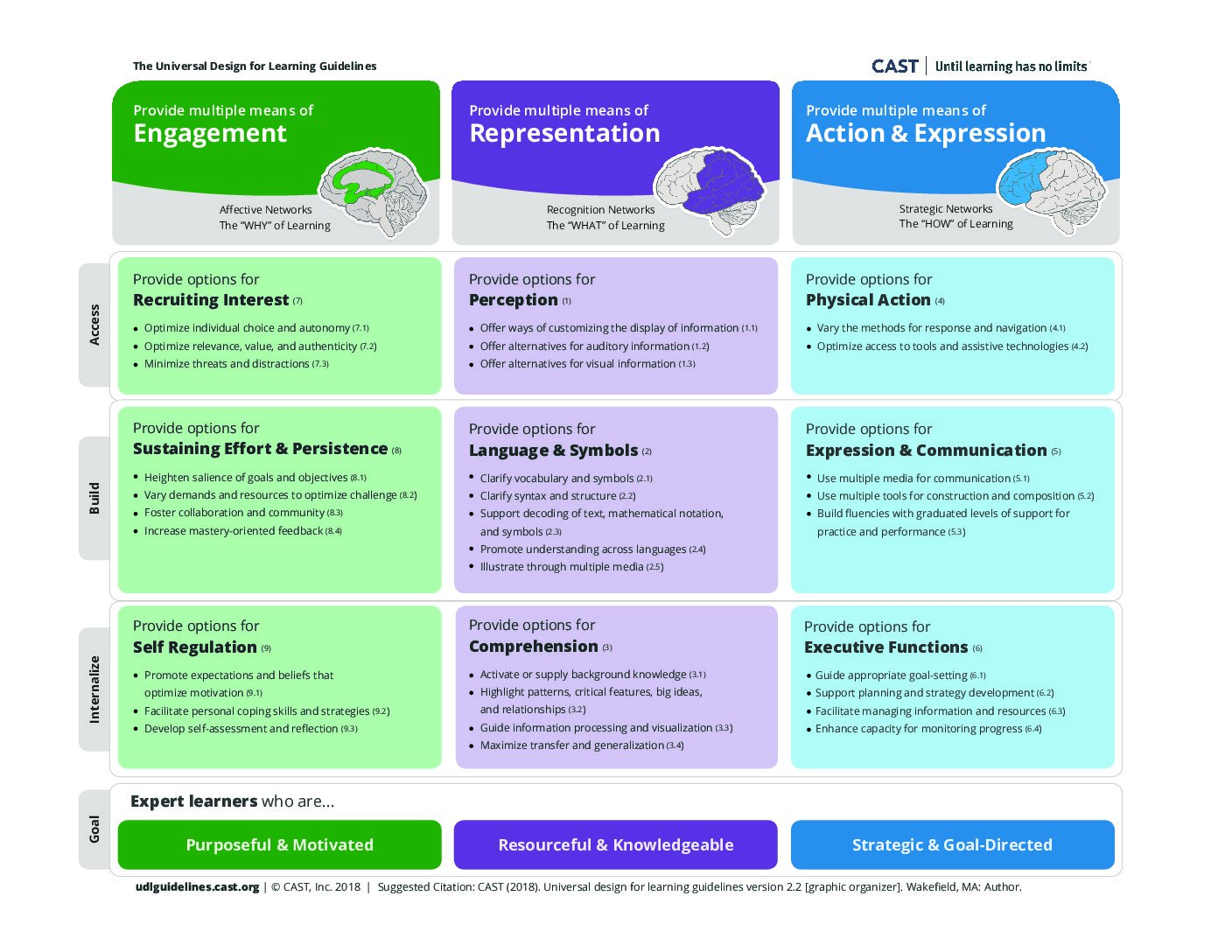Summary
The Universal Design for Learning (UDL) Guidelines are a tool anyone can use to design more accessible and engaging learning environments. However, many educators are quickly overwhelmed by the guidelines when they begin their UDL implementation journey. In this week’s blog, we share a few tips and tricks for preventing paralysis and effectively using the UDL Guidelines to improve instructional practices and better meet the needs of all learners!
By Cassie Stevens, Inclusionary Practices Coordinator
Inclusion starts with increasing a sense of belonging for each and every learner and ultimately inclusion ensures all learners can participate and succeed. Universal Design for Learning gives educators a common approach and language for creating more inclusive classroom lessons, professional learning experiences, and family/community events. It allows our design efforts to be more fruitful because a higher number of learners get what they need. Sounds great, right?
I’ve been talking with many educators and leaders throughout the region focused on implementing Universal Design for Learning (UDL) and I’ve noticed a theme, many educators are diving into UDL implementation, but are completely avoiding CAST’s UDL Guidelines, which is the heart of the framework, without it you really aren’t “doing” UDL. For those district and school leaders participating in NWESD Inclusionary Practices Project (IPP), which provides systems level support for increasing access to learning and engagement in our learners, professional learning involves diving head first in the guidelines knowing that implementing universal design requires three things:
- A shift in mindset! There is no such thing as an average learner. Each and every person is a unique mix of strengths, needs, preferences, interests, and backgrounds. Our system defines certain groups of learners by their deficits – namely, students with disabilities and multilingual learners – when really every learner is a mix of strength and need! Instead of focusing on the student as the barrier, we must shift our thinking and ask ourselves “How might I change the design of my lesson, environment or activity so it’s engaging and accessible to more people?”
- Designing differently! Once you’ve established that you can improve your lesson, environment, or activity, then you can start thinking about what problem you are trying to solve. Proactively name all the barriers that might arise. Prioritize those barriers by asking yourself or your team which ones must be solved first if more learners will engage and benefit from the experience.
- Use of the CAST UDL Guidelines! Yep! You have to use the guidelines if you want to implement UDL. The guidelines offer concrete suggestions for improving your design and activating all networks of the brain necessary for deep learning to occur.
Number 3 is where many get stuck. At first glance, CAST’s UDL Guidelines can feel a bit daunting. Whether you are planning an upcoming staff meeting, your next classroom lesson, or spring conferences, here are three easy ways to get started with utilizing the UDL Guidelines so you can successfully reach more learners, adults and kids alike:
- The UDL Guidelines are NOT a checklist. You do not need to design a lesson that attends to every single checkpoint (bullet point) listed in the guidelines. Instead, identify one to two barriers with which a learner or a group of learners struggle, then use the framework to guide your planning. For example, your learners may be saying “this is too hard” or “this is way too easy.” The barrier has been identified! If you look to the UDL Guidelines for help, you will find that under Engagement, Sustaining Effort and Persistence checkpoint 8.2 has options for “varying demands and resources to optimize challenge.” The suggestion “differentiate the degree of difficulty or complexity within which core activities can be complete” sparks an idea of what you might try next in an upcoming unit revamping your math choice board. Or aids you in the design of three breakout sessions of varying complexity that staff will get to choose from at your next staff meeting. Brilliant! You have used the guidelines to create more accessible learning.
*Need ideas connecting barriers to the UDL guidelines? Use this resource: Barrier ID Flowchart and Barrier ID Flowchart Video for how to use the tool.
2. Another way to utilize the UDL Guidelines is to focus on the top row labeled “access.” Focusing on “recruiting interest,” “perception,” and “physical action” in your design will ensure you are using the guidelines as a means of activating all three networks of the brain. When all three networks are activated, deep learning will occur. When in doubt, use the top row of the framework to guide your planning. Hint: Choose one checkpoint (bullet point) under each guideline that is most necessary for your learners. Again, it’s not a checklist!
3. If options one and two are still too much, then take the plus one approach, a method for UDL lesson planning developed by Jennifer Pusatari. What’s just one thing you can do to create a more engaging or accessible experience? Maybe you want to increase individual choice and autonomy (7.1) or maybe you want to foster collaboration and community (8.3), or maybe you’ve been wanting to provide information in other ways than just text (2.5). No matter what you choose, the framework will guide you to increase your use of UDL aligned strategies. Once you see how it goes with just one idea, you may be encouraged to try something new, all the while improving your instructional practices.
Source: CAST: Transform Your Teaching with UDL by Jennifer Pusateri
As you implement Universal Design for Learning, remember to be upfront with your learners and routinely get their insights and input. Let the learners know what barriers you’ve noticed, how you’re going to try to overcome those barriers to learning, and then ask, “how did that work for you?” Increasing opportunities for learners to provide feedback and even design options with you will improve relationships, engagement, and create learning communities where learners feel empowered!
UDL implementation takes time! It’s a complex framework, but you can get started with just one small step. I promise you and your learners will benefit from the experience!





